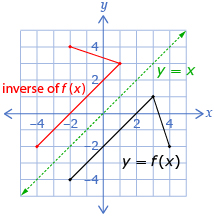Lesson 5 Summary
If relations f and g undo each other, they are called inverses. If f and g are both functions, g is often written as f −1. You have seen that the domain and range of the function become the range and domain of the inverse, respectively. This will always be true of inverses.
To determine an inverse graphically, switch the x- and y-coordinates of each point of the original graph to determine points of the inverse. The inverse of a function may or may not be a function. Just as you can check if a relation is a function by using the vertical line test, a horizontal line test can be used on the original graph to determine if the inverse of that relation will be a function. If it is possible for a horizontal line to cross the graph of a relation at more than one point, the inverse will not be a function.

This diagram shows y = f(x) and its inverse. The inverse is not labelled y = f −1(x) because the inverse is not a function.
You have also found that it is possible to determine the equation of an inverse given the equation of a function. One method used is to replace f(x) with y, switch x and y, and then solve for y. Then f(x) is replaced with y to avoid equations that contain the variable f(x), which can be confusing. Take note of when it is appropriate to use function notation to represent an inverse and when it is not appropriate.
Although this is the end of the transformations module, many of these ideas will recur throughout the course. In Module 2 you will focus on radical functions.